
Kota Kinabalu International Airport
Encyclopedia
Kota Kinabalu International Airport (KKIA) serves the city of Kota Kinabalu
, the state capital of Sabah
, Malaysia. It is located about 8 km southwest of the city centre. It is the second busiest airport in Malaysia
after Kuala Lumpur International Airport
, handling 4.8 million passengers in 2009. It is the main gateway into the state of Sabah and into Borneo
.
The new Terminal 1 building has 64 check-in counters for international and domestic flights; 17 aircraft parking bays capable of accommodating both the wide and narrow body aircraft and the terminal building can handle 3,200 passengers per peak hour.
The Departure Hall column head design is inspired by the ‘Wakid’ basket design. A ‘Wakid’ is a symbolic native practice in preparing for a meaningful journey. Some ethnic pattern of the Rungus and Bajau were also applied in the floor tiles pattern. The floor size at Level 1 is 24,128 sqm, Level 2 is 18,511.4 sqm and Level 3 is 22,339 sqm providing sufficient comfort space for all passengers. The new terminal has also been configured with 12 aerobridges.
The terminal has a total of seven luggage x-ray machines installed. For hand luggage, there is one for VIP, three for departure and one for staff entrance while two machines are available for baggage check-in. It is also configured with a total of 36 immigration counters, 16 for departures and 20 for arrivals. There are also six baggage carousels available. Commercial activities are offered via duty free shops, retail outlets and food & beverage outlets.
built by the Japanese occupying forces
during World-War II. It was then known as Jesselton Airfield (Kota Kinabalu was previously known as Jesselton). Towards the end of the war, it suffered severe bombings by Allied Forces
until the surrender of the Japanese army in 1945.
After the war, the Department of Civil Aviation (DCA) of North Borneo (now Sabah) took charge of the operations and maintenance of the airport. In 1957, the original grass strip runway was resurfaced with bitumen material and a new terminal was built. By 1959, the runway was extended to 1,593 metres long to enable the operation of Malaysia Airways Viscount aircraft
. In 1963, there was the reinforcement and further expansion of the runway to 1,921 meters long to cater for Comet 4
operations. Commercial flights and passenger arrivals gradually increased and a larger terminal building was needed to accommodate this increase.
In 1969 a British consultancy firm was appointed to formulate a Master Plan for a phased and organised development of KKIA from 1970 until 2000 and years beyond. The master plan was submitted to the government with the following recommendations:
Around the 1970s to 1980s, a newer terminal building was built on the other side of the runway. Almost all commercial flights were shifted to this newer and larger terminal. From then on until recently, the original terminal became known as Airport Lama ("old airport"). In 1992, the DCA of Sabah was corporatised, and Malaysia Airports Holdings Berhad
took over management and operations of the airport. Further expansion project began in 2006 for both terminals (see below), and in January 2007 the original terminal was rebranded Terminal 2, and the other became known as Terminal 1.
s, one Airbus A330
, seven Boeing 737
s, three Fokker 50s and three Dornier
s at any one time. It will also have 12 jetways for passenger use. The present air traffic control tower which is attached to the main terminal building will be demolished and will be replaced by a separate, stand alone tower. The whole project including the runway extension is scheduled to be completed by mid-2009.
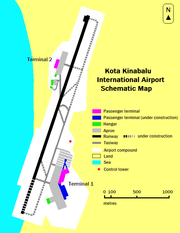 When the overall project is completed, the airport will be able to accommodate the Airbus A380
When the overall project is completed, the airport will be able to accommodate the Airbus A380
, the world's largest passenger aircraft. The airport will also be the second largest airport in Malaysia with an annual capacity of 12 million passengers — 9 million from Terminal 1 and 3 million from Terminal 2.
of KKIA located at Kepayan area. It can be accessed via Jalan Kepayan, Jalan Lintas and Jalan Putatan. Currently, the main tel is undergoing a massive renovation and expansion. When it's completed, the terminal would be capable of handling 9 million passengers annually compare to its previous capacity which is 2.5 million passengers annually. It also features duty-free shop
s, other shops, lounges
, travel agents
, restaurant
s, and many others.
Terminal 1's new wing (phase 1) was completed and opened for commercial use on August 19, 2008 while the other wing (phase 2) was closed for renovation and is expected to complete by May 2010. It will also have a place for small aircraft passengers. After the whole terminal was completed, the first wing will be accommodating international flights while the second wing will be for domestic flights. After completion, Terminal 1 would be equipped with:
The first flight to depart at the new wing was MH 2637 to Kuala Lumpur
at 0650 hours while the last flight at the old wing was at 0025 hours. Malaysia Airlines
is the main operating airline in this terminal.
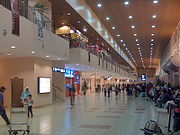
and is located on the other side of the runway from Terminal 1. Terminal 2 is for charter and low cost carrier. Sometime, it is called LCCT. Terminal 2 has recently undergone a major renovation and extension and it re-opened on January 1, 2007 in conjunction with Visit Malaysia Year 2007. It was completed 27 months ahead of schedule. Although it is renovated to serve the low cost carriers, namely AirAsia
, it is not a low cost carrier terminal (LCCT) as that of Kuala Lumpur International Airport's LCCT, as here, other full service airlines may utilize the terminal. It has 26 check-in counters for domestic and international flights and 6 parking bays for B737 and A320 aircraft as well as 7 luggage x-ray machines, a VIP room and 13 immigration counters. The terminal has the capacity to handle 3 million passengers annually.
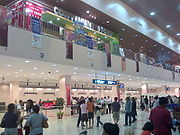
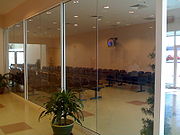 There are 19 airlines operating in KKIA (including charters and seasonals) :
There are 19 airlines operating in KKIA (including charters and seasonals) :
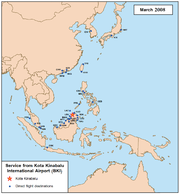
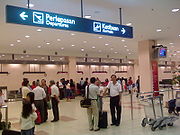
Kota Kinabalu
Kota Kinabalu , formerly known as Jesselton, is the capital of Sabah state in East Malaysia. It is also the capital of the West Coast Division of Sabah. The city is located on the northwest coast of Borneo facing the South China Sea. The Tunku Abdul Rahman National Park lies on one side and Mount...
, the state capital of Sabah
Sabah
Sabah is one of 13 member states of Malaysia. It is located on the northern portion of the island of Borneo. It is the second largest state in the country after Sarawak, which it borders on its southwest. It also shares a border with the province of East Kalimantan of Indonesia in the south...
, Malaysia. It is located about 8 km southwest of the city centre. It is the second busiest airport in Malaysia
Busiest airports in Malaysia
The busiest airports in Malaysia are measured according to data presented by Malaysia Airports Holdings Berhad .- Passenger traffic :...
after Kuala Lumpur International Airport
Kuala Lumpur International Airport
Kuala Lumpur International Airport , or KLIA serves the capital city of Malaysia, Kuala Lumpur, and is one of Southeast Asia's largest airports. It is also Malaysia's main international airport. It is situated in the Sepang district, in the south of the state of Selangor, about from Kuala Lumpur...
, handling 4.8 million passengers in 2009. It is the main gateway into the state of Sabah and into Borneo
Borneo
Borneo is the third largest island in the world and is located north of Java Island, Indonesia, at the geographic centre of Maritime Southeast Asia....
.
The new Terminal 1 building has 64 check-in counters for international and domestic flights; 17 aircraft parking bays capable of accommodating both the wide and narrow body aircraft and the terminal building can handle 3,200 passengers per peak hour.
The Departure Hall column head design is inspired by the ‘Wakid’ basket design. A ‘Wakid’ is a symbolic native practice in preparing for a meaningful journey. Some ethnic pattern of the Rungus and Bajau were also applied in the floor tiles pattern. The floor size at Level 1 is 24,128 sqm, Level 2 is 18,511.4 sqm and Level 3 is 22,339 sqm providing sufficient comfort space for all passengers. The new terminal has also been configured with 12 aerobridges.
The terminal has a total of seven luggage x-ray machines installed. For hand luggage, there is one for VIP, three for departure and one for staff entrance while two machines are available for baggage check-in. It is also configured with a total of 36 immigration counters, 16 for departures and 20 for arrivals. There are also six baggage carousels available. Commercial activities are offered via duty free shops, retail outlets and food & beverage outlets.
History
The airport first began as a military airfieldAirbase
An airbase is a military airfield that provides basing and support of military aircraft....
built by the Japanese occupying forces
Imperial Japanese Army
-Foundation:During the Meiji Restoration, the military forces loyal to the Emperor were samurai drawn primarily from the loyalist feudal domains of Satsuma and Chōshū...
during World-War II. It was then known as Jesselton Airfield (Kota Kinabalu was previously known as Jesselton). Towards the end of the war, it suffered severe bombings by Allied Forces
Allies of World War II
The Allies of World War II were the countries that opposed the Axis powers during the Second World War . Former Axis states contributing to the Allied victory are not considered Allied states...
until the surrender of the Japanese army in 1945.
After the war, the Department of Civil Aviation (DCA) of North Borneo (now Sabah) took charge of the operations and maintenance of the airport. In 1957, the original grass strip runway was resurfaced with bitumen material and a new terminal was built. By 1959, the runway was extended to 1,593 metres long to enable the operation of Malaysia Airways Viscount aircraft
Vickers Viscount
The Vickers Viscount was a British medium-range turboprop airliner first flown in 1948 by Vickers-Armstrongs, making it the first such aircraft to enter service in the world...
. In 1963, there was the reinforcement and further expansion of the runway to 1,921 meters long to cater for Comet 4
De Havilland Comet
The de Havilland DH 106 Comet was the world's first commercial jet airliner to reach production. Developed and manufactured by de Havilland at the Hatfield, Hertfordshire, United Kingdom headquarters, it first flew in 1949 and was a landmark in aeronautical design...
operations. Commercial flights and passenger arrivals gradually increased and a larger terminal building was needed to accommodate this increase.
In 1969 a British consultancy firm was appointed to formulate a Master Plan for a phased and organised development of KKIA from 1970 until 2000 and years beyond. The master plan was submitted to the government with the following recommendations:
- To reinforce and expand the runway distance to 2,987 meters long to cater for Boeing Jet 707 and 747 operations.
- To build a new terminal complex and parallel taxiway which connects to the runway.
- To provide navigation equipments, communication facilities and a modern light system for the runway.
Around the 1970s to 1980s, a newer terminal building was built on the other side of the runway. Almost all commercial flights were shifted to this newer and larger terminal. From then on until recently, the original terminal became known as Airport Lama ("old airport"). In 1992, the DCA of Sabah was corporatised, and Malaysia Airports Holdings Berhad
Malaysia Airports
Malaysia Airports Holdings Berhad is a Malaysian airport company that manages most of the airports in Malaysia. The firm was recently awarded the duty to manage airports in international destinations...
took over management and operations of the airport. Further expansion project began in 2006 for both terminals (see below), and in January 2007 the original terminal was rebranded Terminal 2, and the other became known as Terminal 1.
Expansion and renovation
In mid 2005, the Malaysian government approved a project for major renovation and extension of KKIA worth RM1.4 billion. The project saw the 2988 m (9,803 ft) runway extended to 3780 m (12,402 ft) and the size of the main airport terminal building (Terminal 1) increased from 34000 m² (40,663.7 sq yd) to 87000 m² (104,051.1 sq yd). The new airport terminal building will be able to accommodate four Boeing 747Boeing 747
The Boeing 747 is a wide-body commercial airliner and cargo transport, often referred to by its original nickname, Jumbo Jet, or Queen of the Skies. It is among the world's most recognizable aircraft, and was the first wide-body ever produced...
s, one Airbus A330
Airbus A330
The Airbus A330 is a wide-body twin-engine jet airliner made by Airbus, a division of EADS. Versions of the A330 have a range of and can accommodate up to 335 passengers in a two-class layout or carry of cargo....
, seven Boeing 737
Boeing 737
The Boeing 737 is a short- to medium-range, twin-engine narrow-body jet airliner. Originally developed as a shorter, lower-cost twin-engine airliner derived from Boeing's 707 and 727, the 737 has developed into a family of nine passenger models with a capacity of 85 to 215 passengers...
s, three Fokker 50s and three Dornier
Dornier
Dornier may refer to:* Claudius Dornier , German aircraft designer and builder** Dornier Flugzeugwerke, German aircraft manufacturer founded in 1914 by Claudius Dornier* Dornier Consulting, international consulting and project management company...
s at any one time. It will also have 12 jetways for passenger use. The present air traffic control tower which is attached to the main terminal building will be demolished and will be replaced by a separate, stand alone tower. The whole project including the runway extension is scheduled to be completed by mid-2009.

Airbus A380
The Airbus A380 is a double-deck, wide-body, four-engine jet airliner manufactured by the European corporation Airbus, a subsidiary of EADS. It is the largest passenger airliner in the world. Due to its size, many airports had to modify and improve facilities to accommodate it...
, the world's largest passenger aircraft. The airport will also be the second largest airport in Malaysia with an annual capacity of 12 million passengers — 9 million from Terminal 1 and 3 million from Terminal 2.
Terminal 1
Terminal 1 is the main terminalAirport terminal
An airport terminal is a building at an airport where passengers transfer between ground transportation and the facilities that allow them to board and disembark from aircraft....
of KKIA located at Kepayan area. It can be accessed via Jalan Kepayan, Jalan Lintas and Jalan Putatan. Currently, the main tel is undergoing a massive renovation and expansion. When it's completed, the terminal would be capable of handling 9 million passengers annually compare to its previous capacity which is 2.5 million passengers annually. It also features duty-free shop
Duty-free shop
Duty-free shops are retail outlets that are exempt from the payment of certain local or national taxes and duties, on the requirement that the goods sold will be sold to travelers who will take them out of the country...
s, other shops, lounges
Airport lounge
An airport lounge is a lounge owned by a particular airline . Many offer private meeting rooms, phone, fax, wireless and Internet access and other business services, along with provisions to enhance comfort such as free drinks and snacks...
, travel agents
Travel agency
A travel agency is a retail business that sells travel related products and services to customers on behalf of suppliers such as airlines, car rentals, cruise lines, hotels, railways, sightseeing tours and package holidays that combine several products...
, restaurant
Restaurant
A restaurant is an establishment which prepares and serves food and drink to customers in return for money. Meals are generally served and eaten on premises, but many restaurants also offer take-out and food delivery services...
s, and many others.
Terminal 1's new wing (phase 1) was completed and opened for commercial use on August 19, 2008 while the other wing (phase 2) was closed for renovation and is expected to complete by May 2010. It will also have a place for small aircraft passengers. After the whole terminal was completed, the first wing will be accommodating international flights while the second wing will be for domestic flights. After completion, Terminal 1 would be equipped with:
- 64 check-in counters for international and domestic flights
- 2 baggage x-ray check-in machines and 5 hand luggage x-ray machines (3 for departure, 1 for VIP and 1 for staff)
- 36 Immigration counters (16 for departures and 20 for arrivals)
- 6 baggage carousels
- 3 floor level (Ground floor: Arrival Hall, First Floor: Office and Airline company, Second Floor: Check-in counter and departure hall)
- 9 aerobridges
- 17 aircraft parking bays capable of accommodating both the wide and narrow body aircraft
- 1,400 car park and dedicated parking area
The first flight to depart at the new wing was MH 2637 to Kuala Lumpur
Kuala Lumpur
Kuala Lumpur is the capital and the second largest city in Malaysia by population. The city proper, making up an area of , has a population of 1.4 million as of 2010. Greater Kuala Lumpur, also known as the Klang Valley, is an urban agglomeration of 7.2 million...
at 0650 hours while the last flight at the old wing was at 0025 hours. Malaysia Airlines
Malaysia Airlines
Malaysian Airline System Berhad , DBA Malaysia Airlines , is the government-owned flag carrier of Malaysia. Malaysia Airlines operates flights from its home base, Kuala Lumpur International Airport, and its eastern hub in Kota Kinabalu. It has its headquarters on the grounds of Sultan Abdul Aziz...
is the main operating airline in this terminal.

Terminal 2
What is today Terminal 2 used to be the original terminal building of the airport when it was first built. It is accessed via Jalan Mat Salleh in Tanjung AruTanjung Aru
Tanjung Aru is a sub-district of Kota Kinabalu of Sabah, in Malaysia. Its main feature is its beach called Tanjung Aru Beach which stretches to over 2 kilometres long. It also has its own township called Pekan Tanjung Aru...
and is located on the other side of the runway from Terminal 1. Terminal 2 is for charter and low cost carrier. Sometime, it is called LCCT. Terminal 2 has recently undergone a major renovation and extension and it re-opened on January 1, 2007 in conjunction with Visit Malaysia Year 2007. It was completed 27 months ahead of schedule. Although it is renovated to serve the low cost carriers, namely AirAsia
AirAsia
AirAsia Berhad is a Malaysian-based low-cost airline. AirAsia is Asia's largest low-fare, no-frills airline and a pioneer of low-cost travel in Asia. AirAsia group operates scheduled domestic and international flights to over 400 destinations spanning 25 countries. Its main hub is the Low-Cost...
, it is not a low cost carrier terminal (LCCT) as that of Kuala Lumpur International Airport's LCCT, as here, other full service airlines may utilize the terminal. It has 26 check-in counters for domestic and international flights and 6 parking bays for B737 and A320 aircraft as well as 7 luggage x-ray machines, a VIP room and 13 immigration counters. The terminal has the capacity to handle 3 million passengers annually.
Airlines and destinations


Scheduled
Traffic

| Year | Passenger movements | Aircraft movements |
|---|---|---|
| 1960 | 33,570 | - |
| 1970 | 290,575 | - |
| 1975 | 520,540 | - |
| 1980 | 1,246,130 | - |
| 1985 | 1,430,000 | - |
| 1990 | 2,040,000 | - |
| 2000 | 3,092,326 | 41,411 |
| 2001 | 3,036,196 1.8% | 40,157 |
| 2002 | 3,256,212 7.3% | 44,528 |
| 2003 | 3,302,366 1.4% | 44,701 |
| 2004 | 3,918,201 18.7% | 50,313 |
| 2005 | 3,975,136 1.5% | 51,824 |
| 2006 | 4,015,221 1% | 50,594 |
| 2007 | 4,399,939 9.6% | 52,047 |
| 2008 | 4,689,164 6.6% | 54,317 |
| 2009 | 4,868,526 3.8% | 53,554 |
| 2010 | 5,223,000 6.8% | 55,241 |
Statistics
| Rank | Destinations | Frequency (Weekly) |
|---|---|---|
| 1 |  Hong Kong (KA, MH, AK) Hong Kong (KA, MH, AK) |
19 |
| 2 |  Singapore (AK, MI) Singapore (AK, MI) |
14 |
| 3 |  Bandar Seri Begawan (BI, MH) Bandar Seri Begawan (BI, MH) |
15 |
| 4 |  Seoul (MH, OZ, ZE) Seoul (MH, OZ, ZE) |
16 |
| 5 |  Taipei (MH, AK) Taipei (MH, AK) |
14 |
| 6 |  Manila (AK, 5J) Manila (AK, 5J) |
10 |
| 7 |  Shenzhen (AK) Shenzhen (AK) |
7 |
| 8 |  Tokyo (MH) Tokyo (MH) |
4 |
| 9 |  Jakarta (AK) Jakarta (AK) |
3 |
| 10 |  Perth (MH) Perth (MH) |
3 |
| 11 |  Osaka (MH) Osaka (MH) |
2 |
| Rank | Destinations | Frequency (Weekly) |
|---|---|---|
| 1 |  Kuala Lumpur (AK, MH) Kuala Lumpur (AK, MH) |
140 |
| 2 |  Miri (AK, MH) Miri (AK, MH) |
49 |
| 3 |  Sandakan (AK, MH) Sandakan (AK, MH) |
42 |
| 3 |  Tawau (AK, MH) Tawau (AK, MH) |
42 |
| 5 |  Kuching (AK, MH) Kuching (AK, MH) |
35 |
| 6 |  Lahad Datu (MH) Lahad Datu (MH) |
28 |
| 7 |  Labuan (AK, MH) Labuan (AK, MH) |
21 |
| 8 |  Johor Bahru (AK) Johor Bahru (AK) |
14 |
| 9 |  Kudat (MH) Kudat (MH) |
7 |
| 9 |  Mulu (MH) Mulu (MH) |
7 |
| 9 | .svg.png) Penang (AK) Penang (AK) |
7 |
Incidents and accidents
- 6 June 1976 - A chartered Sabah AirSabah AirPenerbangan Sabah Sdn Bhd, trading as SabahAir , is an airline based in Sabah, Malaysia.- History :...
carrying government ministers crashed in nearby Sembulan upon descending towards the airport killing 11 passengers including the then Chief Minister of Sabah Tun Fuad StephensTun Fuad StephensTun Haji Mohammad Fuad Stephens, previously known as, Donald Stephens, was the first Chief Minister of the state of Sabah in Malaysia. He played a fundamental role in bringing the state of Sabah into the Federation of Malaysia in 1963. He held the chief minister post until 1964, and again in 1976...
. The crash became known as the "Double Six TragedyDouble Six TragedyThe Double Six Tragedy, also known as the Double Six Crash, was a plane crash which took place on June 6, 1976 in Kota Kinabalu, Malaysia. The plane, operated by Sabah Air, coming from Labuan crashed in the sub-district of Sembulan in Kota Kinabalu upon approaching Kota Kinabalu International Airport...
". - 6 September 1991 - An executive private executive jet with 10 Americans and two Britons on board crashed into the jungle near Hulu Kimanis, Papar, about 50 km from here.
- 16 November 1991 - Three policemen perished after their 11-seater Pilatus PorterPilatus PC-6|-See also:-References:* Lambert, Mark. Jane's All The World's Aircraft 1993–1994. Coulsdon, UK: Jane's Data Division, 1993. ISBN 0 7106 1066 1.* Taylor, John W. R. Janes's All The World's Aircraft 1965–66. London: Sampson Low, Marston & Company, 1965....
Royal Malaysian Police aircraft crashed at the Kota Kinabalu International Airport. - 18 September 1993 - A 13.5 square-metre depressionDepression (geology)A depression in geology is a landform sunken or depressed below the surrounding area. Depressions may be formed by various mechanisms.Structural or tectonic related:...
occurred at the edge of the runway the airport had to closed for 70 minutes. - 18 July 2003 - On Dragonair flight 60, an Airbus A330-342Airbus A330The Airbus A330 is a wide-body twin-engine jet airliner made by Airbus, a division of EADS. Versions of the A330 have a range of and can accommodate up to 335 passengers in a two-class layout or carry of cargo....
from Hong KongHong Kong International AirportHong Kong International Airport is the main airport in Hong Kong. It is colloquially known as Chek Lap Kok Airport , being built on the island of Chek Lap Kok by land reclamation, and also to distinguish it from its predecessor, the closed Kai Tak Airport.The airport opened for commercial...
to Kota Kinabalu encountered severe turbulence associated with Tropical Depression Koni over the South China Sea. 12 crew members and 3 passengers were injured, of which 2 crew members sustained serious injuries. The aircraft landed safely at Hong Kong International Airport. - 8 November 2004 - On AirAsia Flight 104, the Boeing 737-300Boeing 737The Boeing 737 is a short- to medium-range, twin-engine narrow-body jet airliner. Originally developed as a shorter, lower-cost twin-engine airliner derived from Boeing's 707 and 727, the 737 has developed into a family of nine passenger models with a capacity of 85 to 215 passengers...
plane carrying 111 passengers and five crew skidded while landing. Three passengers - a five-year-old girl and two women - were injured while evacuating from the plane and received outpatient treatment at the Queen Elizabeth Hospital. - 14 December 2005 - The Kota Kinabalu International Airport was closed for a few hours after an AirAsia plane burst a tire on landing. There were no injuries in the 10.30pm incident.

External links
- Kota Kinabalu International Airport at Malaysia Airports Holdings Berhad
- Kota Kinabalu International Airport at Borneo Trade
- Department of Civil Aviation Sabah
- Photos taken from BKI

